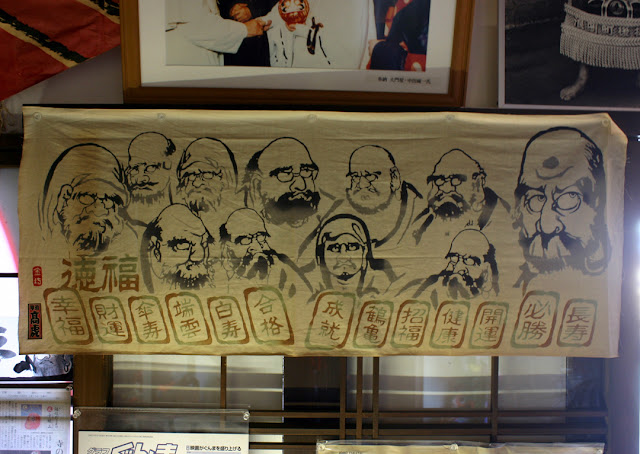


While sorting through pictures from last weeks trip to Japan I ran across these paper mache dolls from the Zen temple in Fujioka. What an experience to go from the solemn hues of the temple structures to these colorful dolls. These figurines of Bodhidharma are used to solidify a practitioner's wish for the future. At the turn of the year the dolls are piled up and burned as a way to release the prayers into the world.
For those unfamiliar with Bodhidharma he is the 28th member of the Buddhist lineage originating with the Śākyamuni Buddha. He is considered the first patriarch of Chinese Buddhism after he brought the religion to the Shaolin Monastary in Henan province. Being from south India the Chinese described him as "the blue eyed barbarian". (Click here for more on Bodhidharma) His large eyes along with furrowed brows and elongated ears would have made him stand out like a sore thumb in rural China. They helped create a tough persona that was backed by his intense meditation practice. Legend states he spent nine years in a remote cave meditating. After falling asleep in his seventh year he cut his eyelids off to prevent his sleeping. As the eyelids hit the ground the first tea leaves grew providing caffeine to help other meditators stay awake. His image is one of the most popular Buddhist icons of China and Japan.
For those unfamiliar with Bodhidharma he is the 28th member of the Buddhist lineage originating with the Śākyamuni Buddha. He is considered the first patriarch of Chinese Buddhism after he brought the religion to the Shaolin Monastary in Henan province. Being from south India the Chinese described him as "the blue eyed barbarian". (Click here for more on Bodhidharma) His large eyes along with furrowed brows and elongated ears would have made him stand out like a sore thumb in rural China. They helped create a tough persona that was backed by his intense meditation practice. Legend states he spent nine years in a remote cave meditating. After falling asleep in his seventh year he cut his eyelids off to prevent his sleeping. As the eyelids hit the ground the first tea leaves grew providing caffeine to help other meditators stay awake. His image is one of the most popular Buddhist icons of China and Japan.
You might recognize the name Shaolin from seventies era Kung Fu movies. Click here to see Jet Li's first film The Shaolin Temple. This connection goes back to Bodhidharma's introduction of martial arts practice to Shaolin's monks."Some Chinese accounts describe Bodhidharma as being disturbed by the poor physical shape of the Shaolin monks, after which he instructed them in techniques to maintain their physical condition as well as teaching meditation. He is said to have taught a series of external exercises called the Eighteen Arhat Hands (Shi-ba Lohan Shou), and an internal practice called the Sinew Metamorphosis Classic.[27] " The temple is still active and regarded as a premier training ground. Click here to see a clip from Empty Mind, a documentary about residents of the current day temple.
If you were a teenager in the nineties you might also recognize Shaolin from the Wu Tang Clan. The famous rap group made numerous references to Shaolin in their album Enter the Wu-Tang (36 Chambers). They even made a Play Station video game, Wu-Tang: Shaolin Style, that featured Method Man, RZA, and other members fighting martial arts masters. Although they only embrace the violent side of martial arts I think it is cool that a major rap group would ally themselves with an ancient Buddhist temple. Financially the game was a brilliant marketing scheme to attract young male gamers to Wu Tang's music. It makes me think I should produce a ceramic combat game. I'd like to see Shoji Hamada fight a Terracotta warrior. With a game like that we could recruit a whole new generation of ceramic artists/gamers.
The intersection between Buddhism and martial arts might have started in Shaolin but it became famous with Japan's Samurai class. They were often practitioners of Zen, a religious form that resulted from the mixing of Chinese Taoism and Buddhism. Ceramic artists owe much to the Samurai as they were instrumental in establishing the tea ceremony. Through this ritual both Buddhism and pottery where elevated in Japanese culture. During my stay in Japan I filmed a tea ceremony that my friend performed for me. In the next few weeks I will post that video and lots of images I took while visiting Mashiko and Tokyo.

No comments:
Post a Comment